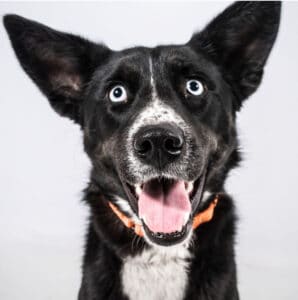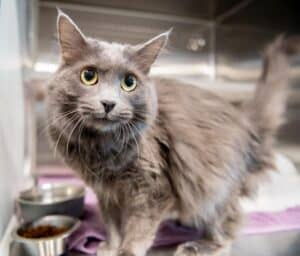
Successful adoptable pet marketing happens when we are able to create meaningful connections between our communities and adoptable animals. The bios we write for adoptable pets should make people feel encouraged to adopt, using positive and easily understood messages with minimal barriers.
To a potential adopter, a barrier is something that makes adopting a pet confusing or difficult. These hurdles can be found in various places such as our policies, paperwork, or even adoptable pet bios, and ultimately may deter potential adopters because they can portray shelter pet adoption as the more difficult or exclusive route to obtaining a pet.
Let’s consider the barriers that we may be unintentionally placing in our adoptable pet bios.

Here’s an example:
“Meet Luna. Luna is a sweet girl who will need time to adjust in her new home. She is dog selective and can be reactive in scary situations. She’s very high energy so she would love to find an adopter who is very active. Luna’s previous owner told us she has separation anxiety, so she would love to find a family that is home most of the time. A dog-to-dog introduction is mandatory to adopt Luna.”
Picture this: A dog lover who has never adopted from a shelter before is browsing adoptable pets online and comes across Luna’s bio. Many people who don’t have experience adopting a pet may have heard phrases like “shelters and rescues make it so hard for people to adopt” or that “shelter pets are all damaged in one way or another.”
We should ask ourselves: does Luna’s bio reinforce those ideas? To a shelter professional or volunteer, Luna’s bio may seem honest, transparent, and straightforward. But to our typical first-time adopter, it might come across as intimidating.
First, Luna’s bio doesn’t tell us how we can actually go about meeting Luna. It states that a dog-to-dog introduction is mandatory, but it doesn’t really explain what that even is or how to set it up. Does an adopter need an appointment to meet Luna? Should they simply just show up at the shelter with their dogs from home? Is there an application that needs to be filled out ahead of time? Where is Luna located and what hours can potential adopters visit her? It’s important that we give clear, concrete instructions on the steps that adopters need to take in order to adopt. When we don’t, it leads to phone calls and emails that we don’t always have time to return in a timely manner or worse: The adopter may be turned off by the idea of pet adoption completely.

We must also consider the language we use. Though many of us animal welfare professionals are fluent in this type of jargon, we sometimes forget that not everyone else is familiar with terms like “selective” and “reactive.” Even phrases like “separation anxiety” and “high energy” have the potential to be misinterpreted by the public. Instead, we should give an example of what Luna’s activity level actually looks like: “Luna appreciates a long walk or even a jog at least once a day, along with plenty of room to romp around and play at home.”
A barrier-free bio doesn’t mean excluding critical information about an animal. While it may be important to convey that certain dogs are reactive, it’s more important that we do a good job in conveying a particular animal’s needs. For example, we can describe a dog that would prefer life as an only pet as “a shining star who doesn’t like sharing the spotlight or your love with other pets.”
So, what would Luna’s bio look like if we wrote it in a more appealing way and without any barriers? Here is an example of how we can write a bio in a clear and communicative way, without using language that discourages potential  adopters:
adopters:
“Lovely Luna is looking for love and adventure! This gentle yet excitable young dog can’t wait to start her new life with you. Luna looks for every opportunity to run around and play but is also affectionate and loyal. Her favorite thing in the world is spending time by her favorite person’s side. New dog friends can sometimes overwhelm her (think of her as a bit of a social introvert), but like people she warms up as she gets to know them. Volunteers rave about her snuggle skills and her ability to catch any ball, anywhere it’s thrown. Luna will be waiting patiently to meet you every day between 11am and 6pm, so stop by and say hello to this fantastic girl!”
We don’t all need to be exceptionally creative writers with master’s degrees in marketing to write an effective adoptable pet bio! There are so many tools and templates that can help us get inspired and help promote even the most complicated or harder-to-place animals for adoption. In fact, check out some of the resources linked below for additional tips, tricks, and templates.
Adoption marketing gives us the chance to be creative, funny, and connect with our communities in a positive and engaging way. If we look at adoptable pet bios through the lens of adoption counseling, we may be missing out on opportunities to get people interested in and excited about pet adoption. When we market our adoptable pets to everyone and not just the “ideal” adopter, there’s a greater chance that we’ll be appealing to people who have never even considered stepping foot inside an animal shelter before, and therefore we’ll be creating even more homes than we considered possible.
Recommended Reading:
Getting Shelter Pets Noticed with Better Bios | HeARTs Speak
Adopter’s Welcome: Marketing that Overcomes Barriers | Humane Pro
Focus on the Present, Not on the Past, to Get Pets Adopted | Maddie’s Fund
Animal Placement Marketing Guide | ASPCA Pro
Watch from HeARTs Speak: Writing Pet Bios using Positive Marketing
Watch from Human Animal Support Services: Ensuring Transparency While Keeping Marketing & Adoption Counseling Seperate

